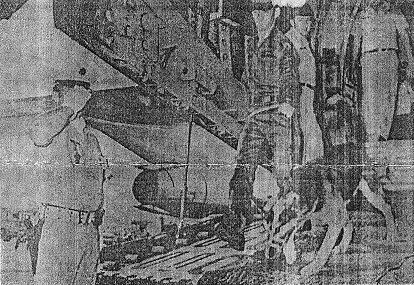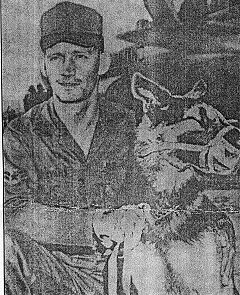|
TAN SON NHUT --- Battle scarred from wounds suffered in the Vietnam
War, Nemo has received first class medical care and is well on the road to recovery.
The Vietnam War is over for Nemo -- an Air Force Sentry Dog credited with
saving his master's life during a battle with four Viet Cong in South Vietnam.
The heroic canine left Tan Son Nhut AB for retirement at the sentry dog training school, Lackland AFB, Tex. Nemo boarded an Air Force C-141 Starlifter at Tan Son Nhut with A2C Melvin W. Bryant, 21 of Port St. Joe, Fla., who is accompanying the dog to Lackland.
Returning to Lackland, Nemo will be a symbol of the professional training sentry dogs
receive and the job they are doing in war-torn Vietnam.
The event that altered Nemo's life began on Dec. 5, 1966. He and his handler, A1C Robert A. Throneburg of Charlotte, N.C., were on patrol at Tan Son Nhut AB. The proceeding day, Tan Son Nhut had been hit by a Viet Cong mortar attack. During the attack about 60 VC swept through an opening they made in the base perimeter's barbed wire fence.
The infiltrators were stopped and turned back by the 377th Security Police Squadron's
main line of defense. But four VC eluded discovery by earlier search parties and
were hiding within the base's perimeter. It was the sentry dog's job to find them.
In the silence of darkness, the two sentries walked cautiously forward.
Suddenly their search ended. Nemo had alerted them to a group of hidden VC.
"Watch him," said Airman Throneburg. The dog's muscles tensed for action. "Get him!" -- was the next command and Nemo lunged savagely forward, into the enemy's nest. Airman Throneburg followed close behind.
In the first moments of encounter, Airman Throneburg killed two of the VC.
But, before additional security police could reach them, Airman Throneburg was wounded in the
shoulder and Nemo's snout was creased by a bullet. The remaining enemy were soon
killed by other security police.
Nemo was credited not only with saving the life of Airman Throneburg, but indirectly
prevented further destruction of life and property at Tan Son Nhut.
The 377th SPS was awarded the Air Force Outstanding Unit Award for its "heroic valor," against the Viet Cong infiltration force.
|
 CANINE HERO RETURNS TO STATES --
CANINE HERO RETURNS TO STATES --
Nemo, a
95-pound Air Force sentry dog who served in Vietnam since January last year, is held by A2C
Melvin W. Bryant of Port St. Joe, Fla., who is accompanying the dog back to the United States.
The 5-year-old K-9 is returning to Lackland AFB, Tex., for retirement.
(Air Force Photo)
The battle was over for Airman Throneburg and Nemo. Master and dog soon
parted. Airman Throneburg was airlifted from South Vietnam, Nemo remained at Tan Son
Nhut For treatment by the base veterinarian, Capt. Raymond T. Huston, of Roseville, Ill.
"When Nemo was brought to me," Doctor Huston said, "he was in pretty bad shape.
I had to do skin grafts on his face and perform a tracheotomy to help him breathe.
His right eye had to be removed, but even this didn't lessen his ability.
It only made his other senses -- hearing and smell -- more sensitive.
Now, eight months after being wounded, he is on his feet and ready to go."
The medical care Nemo received is typical of treatment given all sentry dogs serving in
Vietnam. Whether it is a minor ailment or major surgery, all received first class
medical care.
Most dogs used by the Air Force for sentry dog duty were former house pets. Nemo
belonged to Samuel Cooks Jr., an on-base resident of K.I. Sawyer AFB, Mich. Nemo
attended a special sentry dog training course at Lackland AFB, prior to coming to Vietnam.
Coincidentally, the man taking Nemo home --Melvin Bryant -- has the
same last name as Nemo's original handler, A3C Leonard Bryant who picked him up at Lackland and
brought him to Vietnam in January 1966. Six months later, when Airman Bryant assumed
other duties, Airman Throneburg became the dog's handler.
Taken from Seventh Air Force News --Date: August 9, 1967
|




